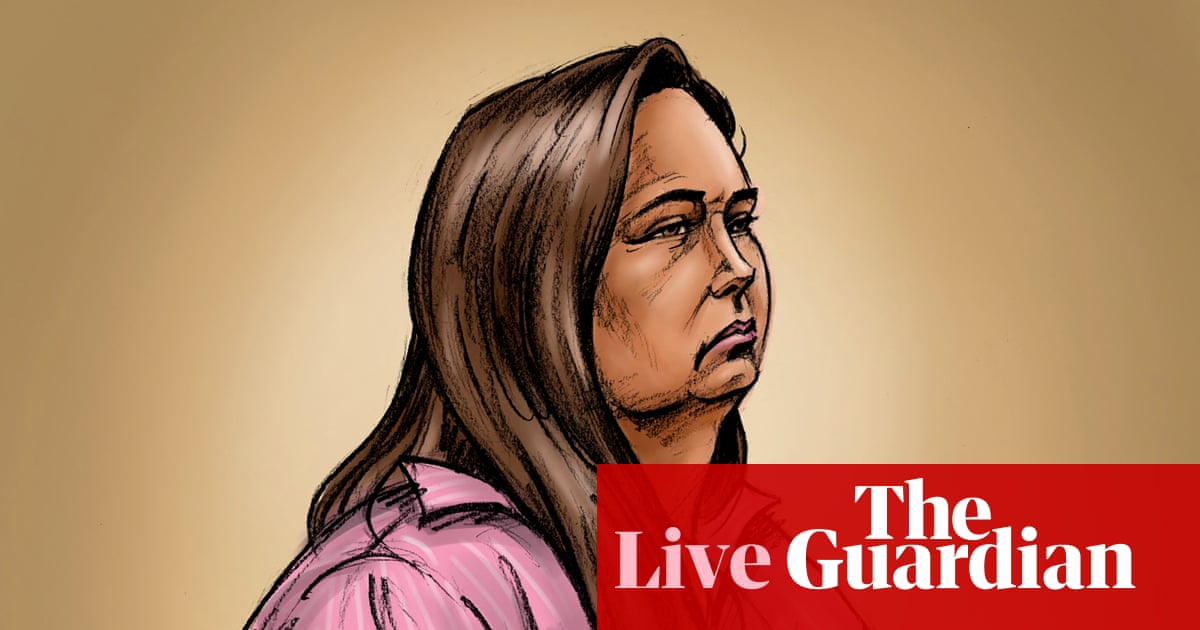‘Highly unlikely’ death cap mushrooms could be purchased from supermarket
Dr Camille Truong says a Victorian Poisons Information Centre toxicologist typically will send photos of mushrooms for identification.
It is “extremely rare” to be asked to identify a mushroom using a sample, she says.
On 31 July 2023, Truong received a call from Dr Laura Muldoon, a toxicology registrar at Monash Health, asking for help to identify the fungi, the court hears.
Muldoon said the hospital had four patients with suspected mushroom poisoning.
The jury is shown an email Muldoon sent to Truong at 12.03pm on the day.
The email includes a photo, which has previously been shown to the jury, showing a brown paste encased in pastry.
Truong says she asked Muldoon if she knew where the mushrooms were sourced from.
I told her that based on this particular photograph I would not be able to give her identification.
Truong says Muldoon told her she understood the mushrooms were bought from a supermarket and a Chinese shop.
Truong says she told Muldoon it was “probably impossible” to be death cap mushrooms, due to them only growing in the wild and being unable to be cultivated.
I also told her there were absolutely no sightings of death cap mushrooms during the last months
Based on the information I received, it was highly unlikely to be a case of death cap mushroom poisoning.
Key events
Expert did not find death cap mushrooms in sample, court hears
Dr Camille Truong was sent a package containing leftovers of the beef wellington meal on 1 August – three days after the lethal lunch at Erin Patterson’s home.
It was a large ziplock bag containing the food item
You could see the item inside.
She put on gloves and sterilised tweezers used a microscope, the court hears.
I saw it was a food item that contained mushrooms inside
I picked out the pieces of mushrooms.
She says she did not find any death cap mushroom pieces.
She then returned the remnants to the bag and placed it in her fridge.
The next day she took the leftovers to the lab at the Royal Botanic Gardens.
“I pulled out all the little pieces of mushrooms on a tray… I also took photographs of the spores I was observing.”
Asked by prosecutor Nanette Rogers SC if she found any death cap mushrooms in the item, she says “no I didn’t”.
Truong says the only mushrooms she found were “field mushrooms” which can be found in supermarkets.
‘Highly unlikely’ death cap mushrooms could be purchased from supermarket
Dr Camille Truong says a Victorian Poisons Information Centre toxicologist typically will send photos of mushrooms for identification.
It is “extremely rare” to be asked to identify a mushroom using a sample, she says.
On 31 July 2023, Truong received a call from Dr Laura Muldoon, a toxicology registrar at Monash Health, asking for help to identify the fungi, the court hears.
Muldoon said the hospital had four patients with suspected mushroom poisoning.
The jury is shown an email Muldoon sent to Truong at 12.03pm on the day.
The email includes a photo, which has previously been shown to the jury, showing a brown paste encased in pastry.
Truong says she asked Muldoon if she knew where the mushrooms were sourced from.
I told her that based on this particular photograph I would not be able to give her identification.
Truong says Muldoon told her she understood the mushrooms were bought from a supermarket and a Chinese shop.
Truong says she told Muldoon it was “probably impossible” to be death cap mushrooms, due to them only growing in the wild and being unable to be cultivated.
I also told her there were absolutely no sightings of death cap mushrooms during the last months
Based on the information I received, it was highly unlikely to be a case of death cap mushroom poisoning.
The prosecution has called their next witness – another mushroom expert
Dr Camille Truong is a mycologist or scientist who studies fungi.
Truong is a research scientist at the Royal Botanic Gardens Victoria, the court hears.
The gardens has an 24-hour on-call mycologist available for the Victorian Poisons Information Centre to help identify mushrooms.
Dr Thomas May concludes evidence
Lawyer Sophie Stafford then turns to a graph showing death cap mushrooms located and removed in the Royal Botanic Gardens Victoria between 2020-2023.
The graph shows March and May is when the largest numbers are located and removed.
Stafford shows May images he was shown by the prosecution during his evidence on Wednesday. The court heard previously these were provided to May by a Victoria police detective.
One photo shows several mushroom caps on a tray.
“You can’t exclude the possibility that these are death cap mushrooms?” Stafford asks.
“I can’t say with any degree of certainty that they’re not death cap mushrooms,” May says.
May agrees he also cannot exclude that they are another mushroom species.
May has now concluded his evidence.
Lawyer Sophie Stafford takes Dr Thomas May through the findings and recommendations made by the coroner about the May 2024 fatal poisoning (that is, unrelated to the Erin Patterson allegations which relate to a 2023 lunch).
May says he was contacted by the Victorian Department of Health about how the government should respond to the recommendations made by the coroner.
One finding by the coroner was for more public health messaging of dangers of consuming wild mushrooms, the court hears.
Defence discusses 2024 death cap mushroom poisoning case
Lawyer Sophie Stafford asks Dr Thomas May about incidents involving death cap mushroom poisoning.
She points to a poisoning that was a subject of a Victorian coroner’s report from May 2024.
Stafford says a now deceased woman had picked mushrooms from her front garden in April 2024. She later used them in a dish she and her son consumed.
The deceased found more mushrooms in her garden the following month. She prepared the same dish with the mushrooms, the court hears.
Early the next day, the woman’s son heard her getting up to use the bathroom. He then checked on his mother. who said she had been vomiting. Her son began to feel unwell the same day.
The woman died from death cap mushroom poisoning while her son recovered, the court hears.
The court is taking a 15-minute break and returning at midday.
Dr Thomas May says when identifying posts on iNaturalist he is not doing so with the same rigour he applies in other contexts.
Stafford continues to show May photos of mushrooms from the iNaturalist website.
He is shown a photo of what is labelled the shaggy parasol mushroom.
May confirm the shaggy parasol mushroom is toxic through his work at the Victorian Poisons Information Centre.
He is also shown a photo of a buttery collybia mushroom. May says it does not grow in Victoria despite a post on iNaturalist reporting it in the state.
Dr May confirms that the genus armillaria – or honey mushroom – grows in Gippsland.
He says that the Victorian variant of these mushrooms is bitter and is not likely to be eaten.
Dr Thomas May discusses Gippsland mushroom sightings
Lawyer Sophie Stafford asks Dr Thomas May about a map of Gippsland from the iNaturalist website, showing scattered red dots.
May says these marks are reported mushroom sightings. He agrees some may be “research-grade” observations and others are unverified observations.
Under cross-examination, May agrees the oudemansiella gigaspora mushroom has similar visual features to the death cap including a smooth cap and white gills.
He agrees he is not aware of it being toxic to humans.
Lawyer Sophie Stafford is taking Dr Thomas May through screenshots of mushroom posts from the citizen science website iNaturalist.
She begins showing May photos of what are labelled stubble rosegill mushrooms on the website. May says he cannot confirm the first and second photo is a stubble rosegill based on the image.
May says the stubble rosegill is not on the list of toxic mushrooms he is aware of. He says he would expect the species to be “quite widespread” in Victoria.
The next mushroom is labelled oudemansiella gigaspora. The photos shows the cap and stem of the mushroom. May says he cannot identify it from the photo.
He says he has identified over 30,000 photos from iNaturalist but will never identify a mushroom where the “underside” or the gills are unable to be seen.
Dr Thomas May began giving his evidence yesterday, telling the court that:
death cap mushrooms were most commonly reported in May
there had been three known sightings of death cap mushrooms in the Gippsland region
the “citizen science” website iNaturalist is often used to report sightings
Catch up on what else the mushroom expert has said so far in this report from our justice and courts reporter, Nino Bucci.
Dr Thomas May says ‘spore print’ and DNA testing can be used to identify death cap mushrooms
Lawyer Sophie Stafford takes Dr Thomas May through the visual features of a death cap mushroom which she says has
May agrees that these are the features he is looking for when trying to identify if a species is a death cap mushroom.
He agrees a “spore print” and DNA testing can also be used to confirm if a mushroom is a death cap – if a sample is available.
May says when providing advice to the Victorian Poisons Information Centre he will qualify his opinion with phrases like “high degree of probability” and “consistency”.
He says when in the field, when seeing the mushroom in its environment, he will often feel more confident to identify a death cap.
Dr Thomas May cross-examined by defence
The defence is continuing their cross-examination of Dr Thomas May, a mycologist or scientist specialising in fungi.
Erin Patterson’s defence lawyer, Sophie Stafford, is cross-examining May.
Under cross-examination, May agrees he has made conclusions in articles that the general public has a poor ability to identify mushrooms.
He also agrees there have been several incidents of misidentification of mushrooms.
“Accordingly, you encourage something you’ve likened to an apprenticeship, which takes a long time to accurately identify mushrooms in the wild,” Stafford says.
“That is correct,” May says.
What we learned on day 10 of Erin Patterson’s murder trial
While we wait for things to begin, here’s what the jury heard on day 10 of Erin Patterson’s triple murder trial:
1. Dr Laura Muldoon, who treated Erin at Monash medical centre, said the mushroom cook appeared “clinically well” on 31 July – two days after the lunch.
2. Medical testing showed Erin had no signs of liver toxicity before she was discharged from Monash medical centre on 1 August, the court heard.
3. Jurors were shown a photo of the remains of the fateful beef wellington meal. The photos show a pastry encasing a brown paste. There are also leftovers of the brown paste in the photo.
4. An internationally renowned mushroom expert, Dr Thomas May, told the court he posted a post of death cap mushrooms he had spotted on a walk to the “citizen science” website iNaturalist. He said the post included several photos, latitude and longitude and geo-coordinates, but not the specific street.
We’re expecting today’s evidence to begin shortly after 10.30am.
The defence are expected to continue the cross-examination of mushroom expert Dr Thomas May, who began giving evidence on Tuesday.
Patterson, 50, faces three charges of murder and one charge of attempted murder relating to a beef wellington lunch she served at her house in Leongatha, in regional Victoria, on 29 July 2023.
She is accused of murdering her in-laws, Don and Gail Patterson, and her estranged husband’s aunt, Heather Wilkinson. The attempted murder charge relates to Heather’s husband, Ian.
She has pleaded not guilty to the charges. The prosecution alleges Patterson deliberately poisoned her lunch guests with “murderous intent”, but her lawyers say the poisoning was a tragic accident.



